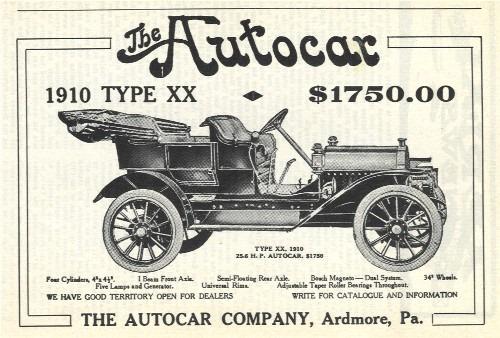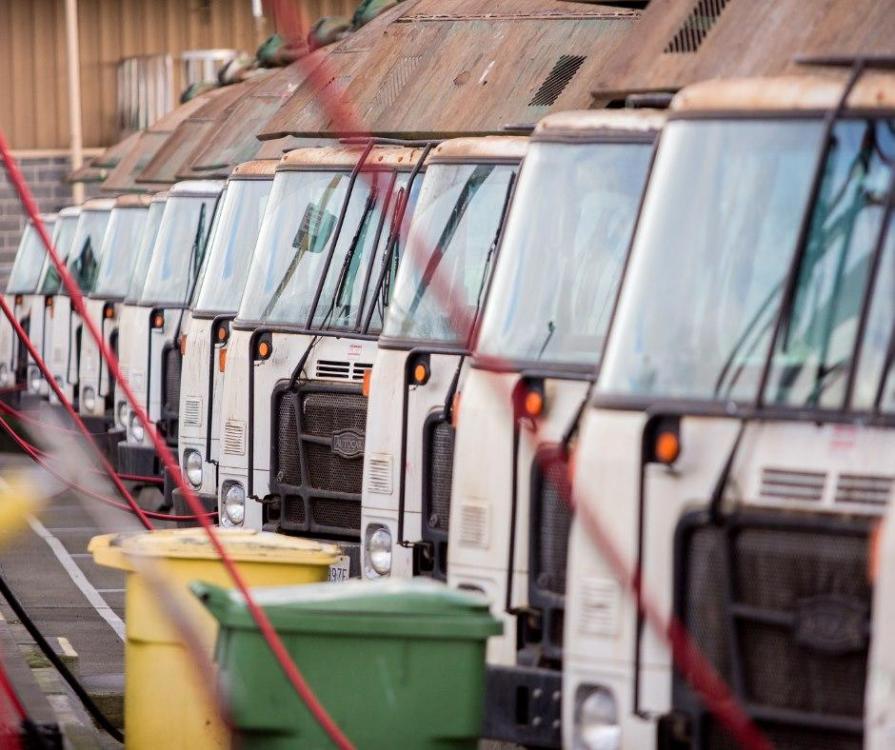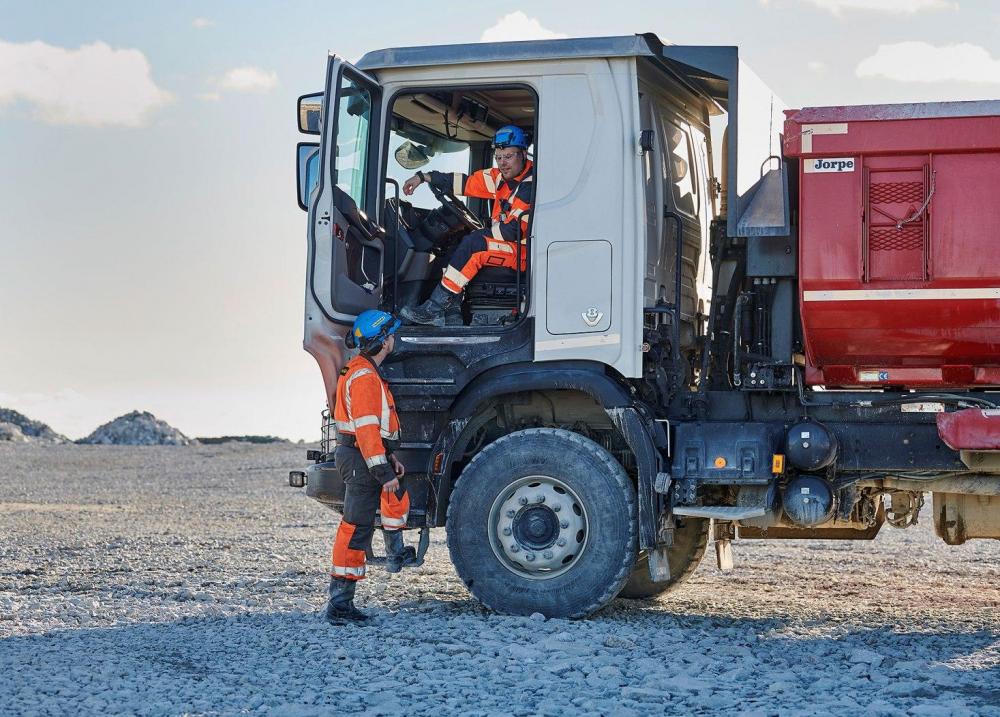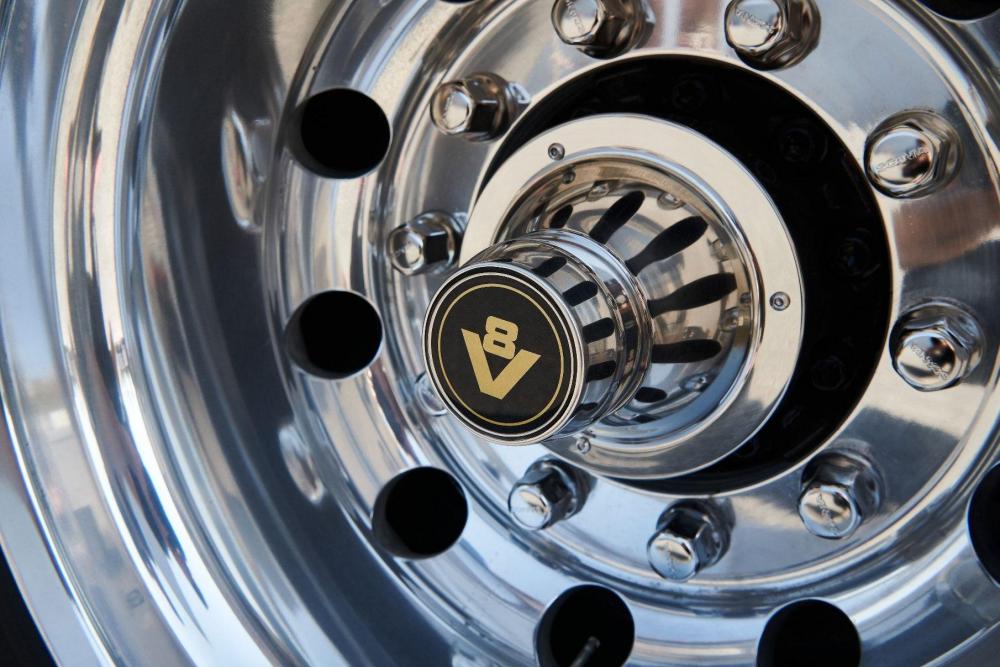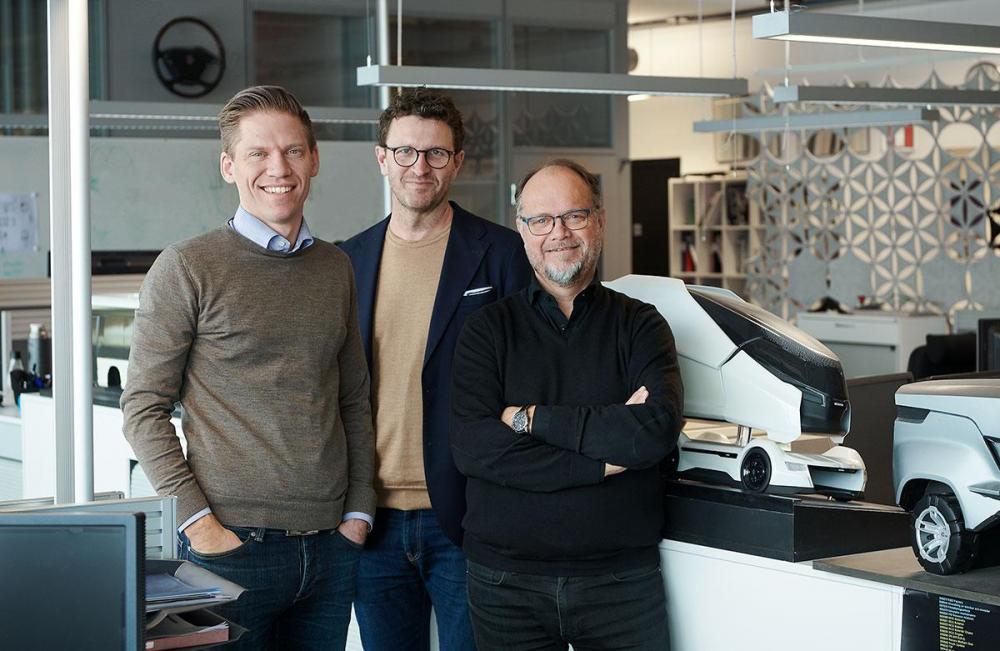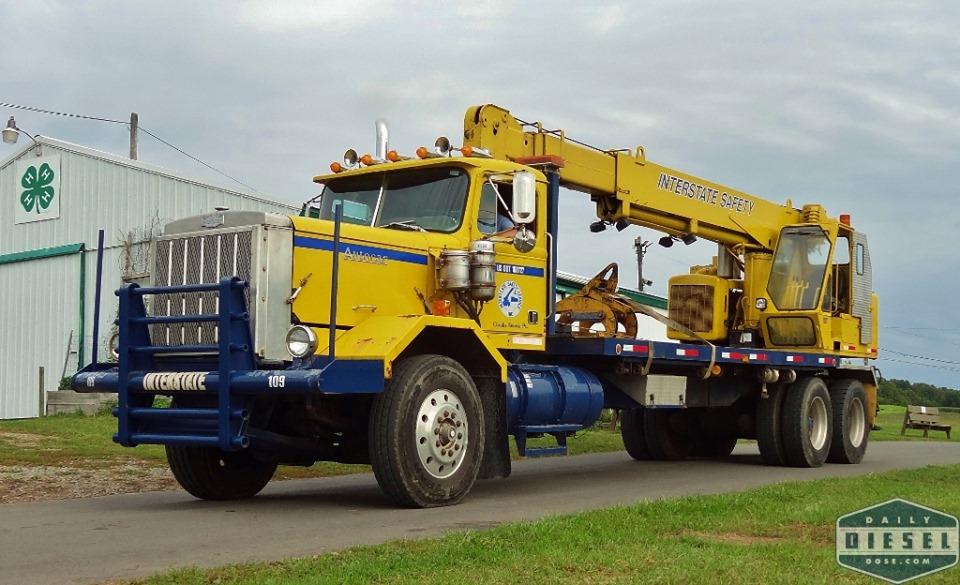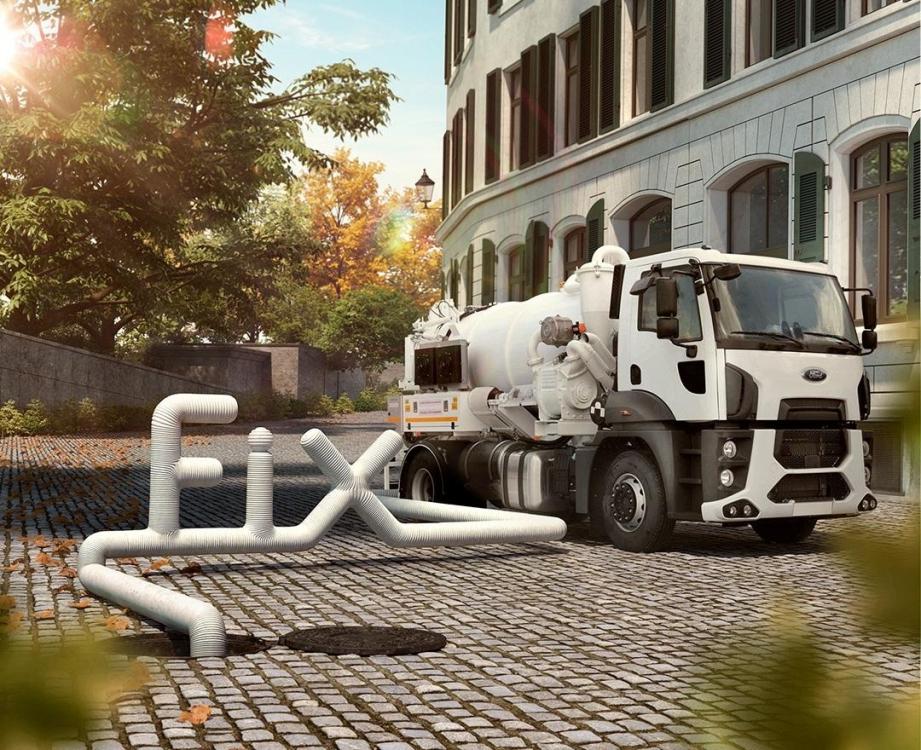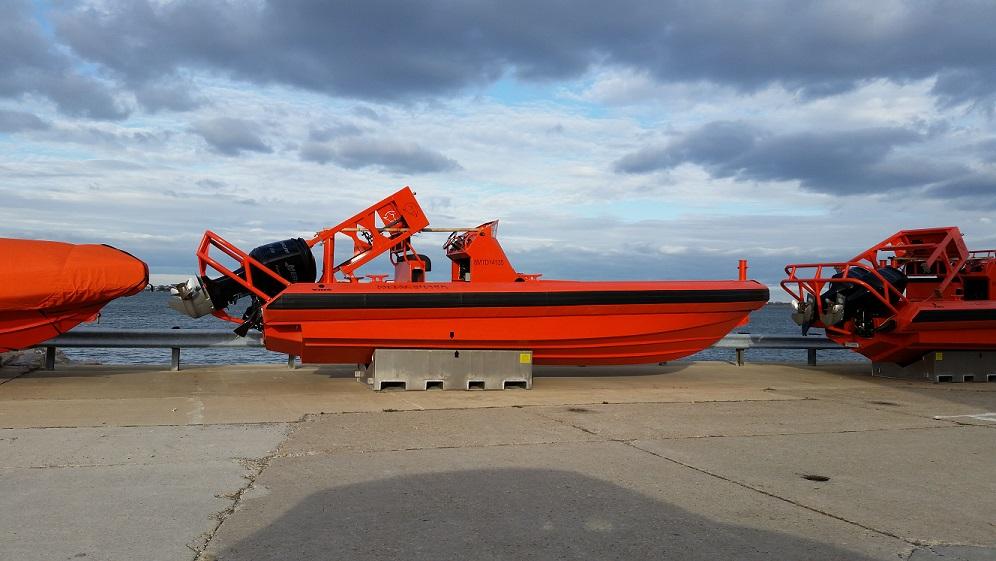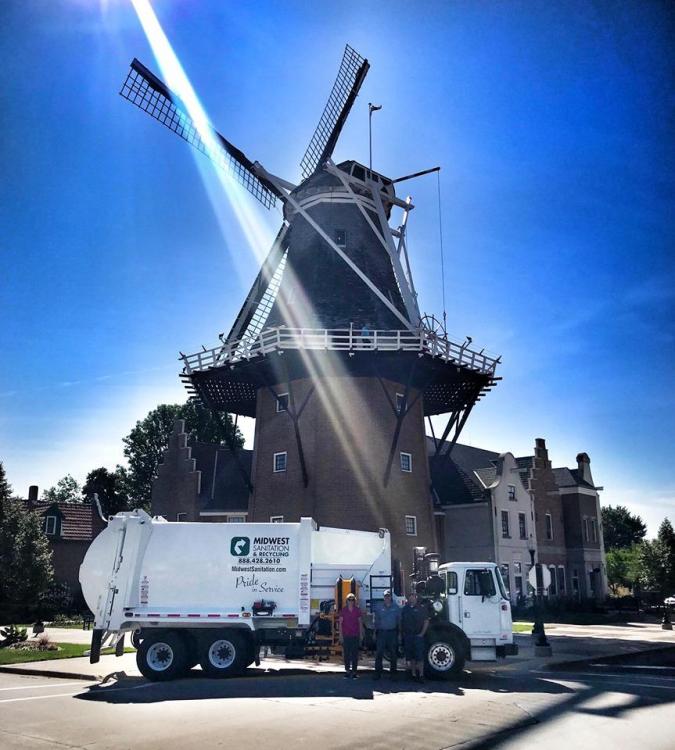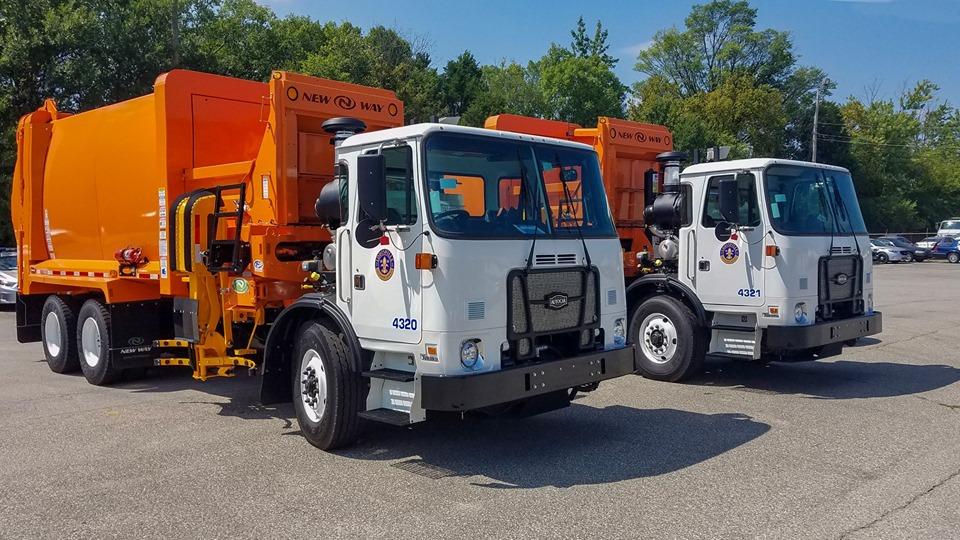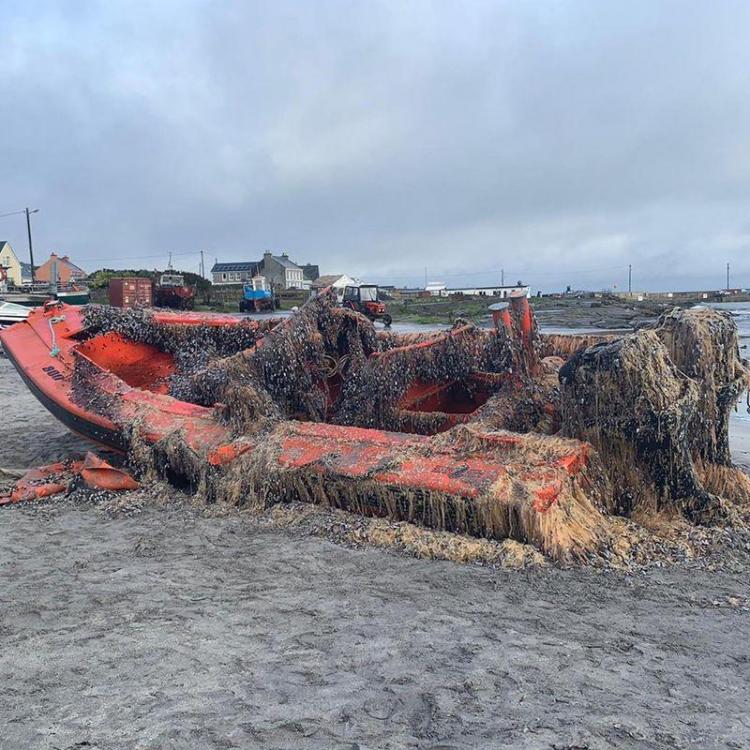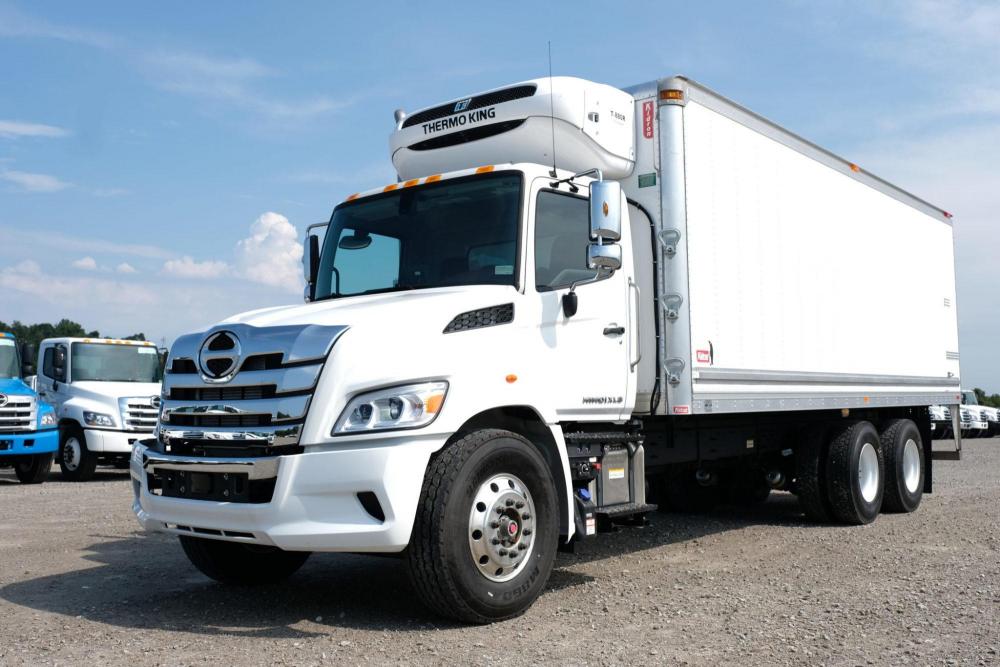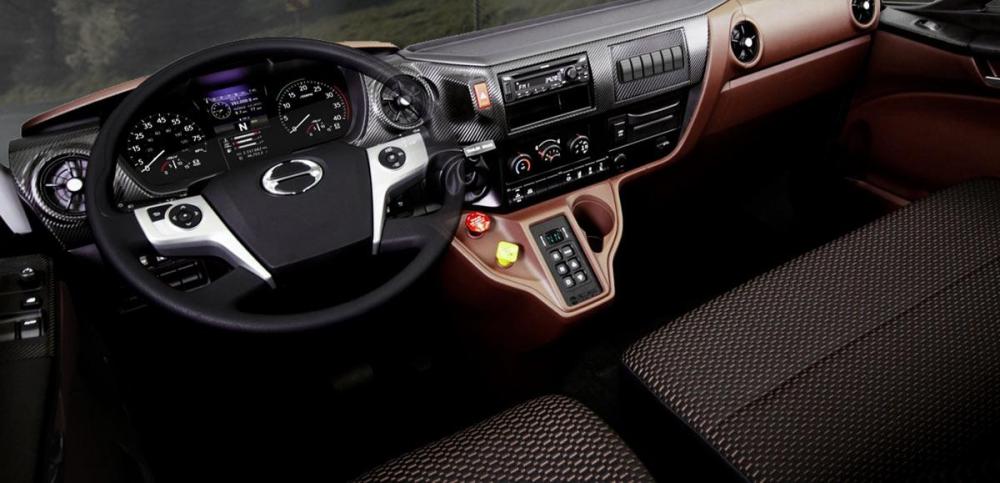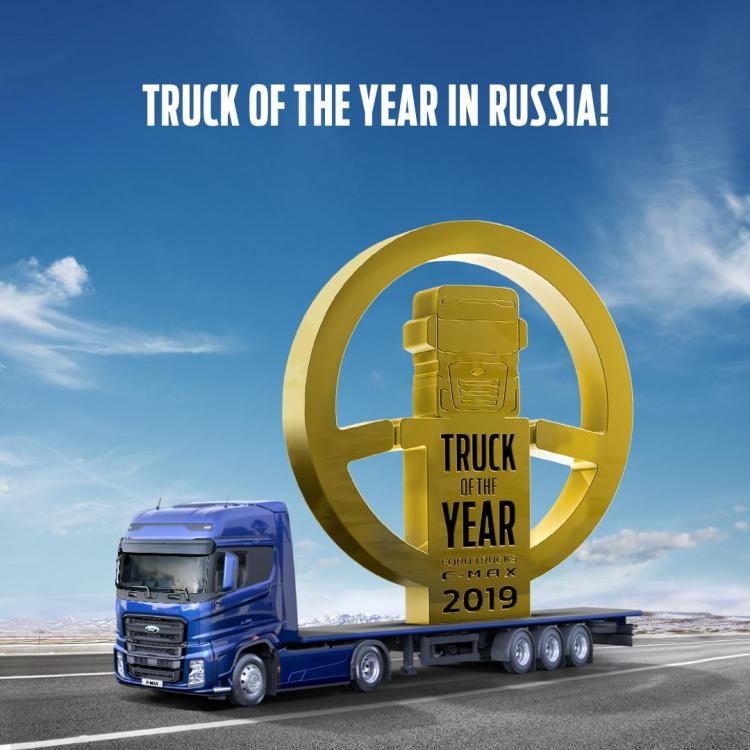
kscarbel2
Moderator-
Posts
18,541 -
Joined
-
Days Won
112
Content Type
Profiles
Forums
Gallery
Events
Blogs
BMT Wiki
Collections
Store
Everything posted by kscarbel2
-
Jack Roberts, Heavy Duty Trucking (HDT) / September 12, 2019 Dublin, Virginia — At the Technology Summit at the Volvo Customer Center in Dublin, Virginia, Volvo Trucks unveiled a host of new and upgraded safety systems as well as a brand-new Class 8 electric VNR tractor. In his opening remarks to journalists attending the Volvo Trucks North America Technology Summit, Roger Alm, president of Volvo Trucks said, “Other truck companies change with the times. Volvo is committed to changing the times.” And looking at the wide array of diverse new products, systems, technologies and upgrades the Swedish truck OEM unveiled during the course of the day it would be hard to argue with him. New Volvo product offerings detailed included a second-generation turbo-compound diesel engine, a new steering assistance system, and upgrades to Volvo’s advanced active safety systems as well as a first-look at an all-new, Class 8 VNR battery-electric tractor. The day began, however, with business news and the announcement of a major investment in Volvo’s North American manufacturing facilities and processes. “We are moving into new technology today. We will start serial production of electric trucks next year,” Alm said. “But the internal combustion engine will be the dominate power source in trucking for many years to come. But we are investing in our product portfolio and bringing new technology to market all the time.” Before a team of Volvo engineers and designers began briefing on the new products being unveiled, however, Alm and Peter Voorhoeve briefed reporters on the state of the North American truck market as seen by Volvo analysts, as well as significant investments in both dealerships and manufacturing facilities. Alm said that if current build rates hold up, he expects to see a total of 311,000 new Class 8 trucks roll onto North American highways this year. That number is a bit lower than the company’s initial estimate of 325,000 units — which Alm said was a natural consequence of the economy slowing down somewhat. Still, Voorhoeve noted that 2019 was shaping up to be a “very good year,” and added that while the economy did indeed seem to be cooling off somewhat, this was to be expected given the red-hot production numbers the industry has seen over the past couple of years. Volvo currently has North American market share of 9.6% — a figure lower than the 10% market share the company posted in 2018. Voorhoeve said this was due to delivery issues that hobbled the company in early 2019 — but that he expected to make up lost ground and finish the year at 10% once again. “In some ways, Volvo is still a new brand in North America,” Voorheve noted, “We’ve been here since 1982.” The success of any truck brand in North America — which remains Volvo’s largest market globally, depends on having a solid dealer network, which Voorheve said Volvo has made a priority from its earliest days in the United States and Canada. To date, he noted, Volvo has invested $619 million in its dealership network, which has grown to 435 locations since 2010, along with a whopping 296% increase in Volvo Master Technicians and a 64% increase in service bays. Building on those successes, Voorhoeve announced that Volvo will invest another $400 million in its New River Valley truck plant in Dublin, where all Volvo trucks sold in North America are built. “The outstanding product line currently produced at NRV has strongly positioned Volvo Trucks for the future,” Voorhoeve said. “This investment is another sign of our confidence in that future, and will help us prepare for even more exciting products – powered by both diesel and electric drivetrains – in the coming years.” Virginia Governor Ralph Northam joined company and local officials to announce the expansion, which will be eligible for a Virginia Major Employment and Investment grant of up to $16.5 million and other incentives. Virginia’s Pulaski County will support the project by granting Volvo 222 acres of adjacent property to expand the campus, and providing $500,000 toward site improvements. In addition to its financial investment, Volvo announced plans to create 777 new jobs at the facility over the next six years. Major components of the investment include a new 350,000-square-foot building that will ultimately house truck cab welding operations; an expansion of the existing plant to allow for further improvements to the facility’s paint operations and overall material/production flow; and a variety of equipment upgrades, including installation of several state-of-the-art dynamometers for vehicle testing. “This investment will give our employees the tools they need to continue providing our customers the highest quality products,” said Franky Marchand, Vice President and General Manager of the NRV plant. “We’re very grateful to the Commonwealth of Virginia, Pulaski County, and the citizens in this community for their continued support of our business and our people. Creating more value-added processes through these investments is good for our employees, our plant and our region.”
-
Back in 1910, Autocar was racing to keep up with demand for its trucks - but still built fancy cars, too. This Autocar Type XX ("Type 20") cost the equivalent of $126,000, but it did have over 25 HP. 😮 In 1911 Autocar built its final car and focused exclusively on trucks. #ThrowbackThursday #TBT Always Up - Autocar Trucks .
-
For every diesel truck we replace with natural gas, we reduce our diesel fuel by an average of 8,000 gallons per year, along with a reduction of 14 metric tons of greenhouse gas emissions per year! #ThinkWM Always Up - Autocar Trucks .
-
Scania Group Press Release / August 26, 2019 Renewable fuels as standard, heavier loads with even more power, advanced driver assistance software and a truck with fewer pieces and lighter materials: the V8 has a fascinating future in store. Since its creation in 1969, the V8’s reputation for power and reliability, plus its iconic emblem and the distinctive rumble of the engine have earned it the title ‘King of the Road’. And yet, the transport industry is being affected by some profound technological and societal changes, such as digitalisation and climate change. Will the king keep his crown in ten or even 20 years’ time? What sort of future does the V8 have? “In the last 20 years we have gone from Euro 3 to Euro 6 and increased the horsepower and the fuel economy, but it still looks like a V8.” “I think there’s definitely a future for the V8,” says Anders Gau, Chief Engineer for V8 Engines at Scania, confidently. “If you look in the rearview mirror and see what it was like ten or 20 years ago, it had eight cylinders, eight pistons, and it looked the same as now. Of course, we have improved it a lot; in the last 20 years, we have gone from Euro 3 to Euro 6 emissions standards, we have increased the horsepower from 580 to 730 and the fuel economy has improved a lot, but it still looks like a V8.” Heavier loads need the V8’s power In particular, now as well as in the future, Gau says that the V8 comes into its own when there are heavy transport needs. “It’s a robust, high-power engine that’s really good for fuel economy and carrying heavy loads, such as in the timber and mining industries,” he explains. “Twenty years is a long time away from now, but we will still see the need for heavy trucks to transport heavy loads, which are core requirements for those industries. You need a strong V8 engine with which to operate.” You might think that these power needs automatically mean that the engines have become bigger and more complicated, as well as even more fuel-thirsty. But in fact, the V8 has gone in the opposite direction. With the latest iteration introduced in 2017, the biggest differences have been the engine’s startling fuel efficiency progression (an average of five percent fuel savings), and its increased robustness. It’s 80 kilogrammes lighter than its predecessor, due mainly to a simplified layout with fewer parts overall. Connectivity: more than electrification in v8’s near future Gau believes that connectivity will have a great bearing on the V8’s future, pointing out that it is already compatible with all the connected services and coaching modules Scania provides. He sees further developments in intelligent drivetrains, making it even easier for the driver to minimise fuel consumption. “With the intelligent powertrain helping you choose the right gears, and knowing what’s going to happen in three kilometres, the driver can then allow the truck’s kinetic energy to propel it. Then you can let go the gas pedal just before reaching the top and roll down the hill, using the kinetic energy to help get it up the next hill. The V8 allows you to use your most efficient gear for a longer time rather than downshifting – you have the power to do that. That’s actually the most energy-efficient approach,” he says. The efficiency of heavier loads In the face of climate change and air pollution, how will the growing need for fossil-free transport solutions affect the V8? Perhaps a big diesel-powered machine like this will have no place in such a future? Jonas Nordh, Director of Sustainable Solutions, begs to differ. “I support the development of the V8 from a sustainability point of view,” he says. “If we won’t have electrification widely available until 2030, we need to have something else meantime, and that’s energy efficiency. Some 25 percent of the reduction of co2 needs to come from energy-efficient solutions.” He explains that the V8’s ability to take on bigger, heavier loads means fewer trucks are needed for specific jobs and consumption levels stay the same, especially using the kinetic energy that Chief V8 Engineer Anders Gau mentions. Indeed, Nordh adds, “This is why the V8 can be a leader in sustainable transport. If you look into what we are doing with the new generation, we are increasing energy efficiency. Our new diesel platform for the V8 already lowers energy consumption, and whether you’re moving one tonne or 76 tonnes, it needs to be done as efficiently as possible. Renewable fuels bring new possibilities Nordh adds, “We need to prioritise the limited amounts of biofuels for the work areas that really need them. We don’t need them for the cities; there, electrification and biogas can work. But for hilly topographies, in mines, and where heavy haulage applications of around 70 to 80 tonnes are required, we need the V8’s power. By running the V8 730 on Bio-fame or HVO, we can also address the co2 issues.” Another gateway to fossil freedom is blending standard and biofuels. At Scania there is a dedicated team that is working on this process. A lighter but stronger vehicle Possible influences on future development also include the advent of stronger but lighter materials such as kevlar and carbon fibres, but Kristofer Hansén, previous Head of Styling, Industrial Design at Scania, sounds a note of caution, saying that these materials have been around for a while and their costliness has slowed their advance. Aluminium is another material that could well figure more in future designs, and Scania is, like others, looking at this and other solutions. “A truck has a lot of pieces right now,” says Hansén. “but perhaps in the future, there will be fewer pieces to make up the chassis, but less weight.” .
-
Deborah Lockridge, Heavy Duty Trucking (HDT) / September 11, 2019 California’s governor is expected to sign into law a bill that critics say would make it difficult, if not impossible, for trucking companies in the state to use independent contractor owner-operator truck drivers. If signed into law, Assembly Bill 5 “will put tens of thousands of owner-operator truckers, who service agriculture, retail and other industry sectors, out of business," said the California Trucking Association in a press release. AB 5 originally passed the California State Assembly back in May, and was passed late in the evening Sept. 10 by the state Senate. It codifies last year’s Dynamex California Supreme Court decision into law, establishing an ABC test to determine status of an independent contractor that would all but eliminate the owner-operator model in the state. According to published reports, Democratic Gov. Gavin Newsom has signaled support for the measure, which would take effect on Jan. 1. It started with Dynamex The state supreme court last year ruled in a case involving Dynamex, a courier company, that certain workers should be presumed employees instead of independent contractors when evaluating wage and hour classification in class action cases. The ruling required companies to use a newly adopted ABC test to determine who is an independent contractor, which consists of certifying: A That the worker is free from the control and direction of the hiring entity in connection with the performance of the work, both under the contract for the performance of the work and in fact; B That the worker performs work that is outside the usual course of the hiring entity’s business; and C That the worker is customarily engaged in an independently established trade, occupation, or business of the same nature as the work performed. “Most legal analysis of the ruling agrees the ABC test sets an impossible standard for most of our members to meet,” the Western States Trucking Association told its members last May, with the sticking point being the “B” provision. Joel M. Van Parys, an attorney with Carothers DiSante & Freudenberger, explained in an analysis for Truckinginfo.com before AB5’s passage that “in order to pass 'prong B' of the Dynamex test, a company must show that a worker is performing work outside of the usual course of the company’s business. If a company’s business is trucking, transportation or logistics, then it will be very difficult for truck drivers to pass this part of the test. In addition, the drivers would have to have independently established businesses or provide trucking services to other companies.” The Los Angeles Times, which called AB5 a “sweeping bill rewriting California employment law,” explained that while the Dynamex decision applied only to rules governing minimum wages, overtime and meal and rest breaks, AB 5 goes further. The legislation would entitle those classified as employees under the ABC test to benefits such as workers’ compensation, unemployment and disability insurance, paid sick days and family leave. The legal firm Scopelitis, Garvin, Light, Hanson & Feary, in an email alert, noted that other than some owner-operators providing services in the construction industry, trucking and gig-economy companies did not receive stand-alone exemptions, “making it likely that such businesses will be subject to the ABC test unless they can satisfy the difficult business-to-business exception.” Construction exception One amendment in the bill allows drivers working within the construction industry to continue operating as independent truckers for a two-year grace period, according to CTA. Joe Rajkovacz, director of governmental affairs for the Western States Trucking Association, told HDT in an interview that some of its members, many of whom are in the construction industry, might have a path forward thanks to a deal cut by United Contractors with organized labor. “The only way for an owner-operator in construction trucking to exist – we’re talking someone with their own authority – is they have to contract directly with a contractor licensed by the state of California. That as you can imagine has all of our broker members fit to be tied.” ‘The sins of the few’ The bill was pushed by labor unions, who have long wanted to organize drivers at the state ports, but cannot because federal law prohibits independent contractors from joining unions. And there is little doubt that there are some trucking companies in the state who have abused the independent contractor model, as highlighted in what the industry criticized as a lopsided USA Today report in late 2007. However, AB5 took a broad-brush approach in banning the use of independent contractors rather than addressing the abuses. “The sins of the few have been extrapolated to the many, and that’s unfair,” Rajcovacz told HDT. The state’s trucking industry had sought to work with legislators to carve out an exception for legitimate independent contractors. Many workers were exempted, among them doctors, dentists, lawyers, engineers, accountants, architects, Realtors, travel agents, graphic designers, and investment advisors – but not trucking, nor “gig” workers such as those for Uber and Lyft. “AB 5 could have been amended to address worker misclassification issues, as well as protect the 70,000 predominantly minority-owned truckers currently operating as independent contractors,” said Shawn Yadon, CEO of the California Trucking Association, in a press release issued by the association. “There is no reason why protecting workers does not include defending the right of tens of thousands of drivers who have built their businesses around the independent owner-operator model, invested hundreds of thousands of dollars in their trucks and have operated their own businesses for decades.” CTA had advocated for changes to AB 5 that would still allow legitimate trucking owner-operators, including requirements for operating authority, ownership of vehicles, exclusivity and transparency about pay. “These changes would have set a clear criterion and established independence in a way that protected employees from misclassification without hurting entire sectors of the business community,” CTA’s release said. In an interview, Yadon told HDT that the bill does not distinguish between a driver who's acting as an independent contractor under a truck lease-purchase program and one who owns his or her own truck outright, independent of a deal with the motor carrier they drive for. “It virtually destroys the independent contractor model for trucking," he said. When asked if he thought legislators truly understood what they were doing to the trucking industry, Yadon told HDT, “The predominant voice of the truckers in Sacramento have been from the owner-operators.... I believe that awareness was made clear [to legislators], not only by the CTA, but also by those dozens and dozens of owner-operators who showed up at committee hearings and testified, gave their own story of how they were building their businesses. So I believe it was pretty clearly stated from a variety of sources, and most importantly from the independent drivers themselves. I would not say there was a lack of understanding.” In California, more than 136,950 trucking companies remain primarily small, locally owned business with small fleets and independent drivers, according to CTA. What will owner-operators and motor carriers do? Meanwhile, motor carriers and owner-operators are left trying to figure out a strategy for what to do next. “AB 5 will have implications that will go beyond employment classification,” said Yadon in the release. “Like the rest of the nation, California is experiencing a shortage of truck drivers, this measure will aggravate the problem by removing thousands of drivers from rosters as many have indicated they will move to other states or seek a different line of work all together.” In fact, Rajkovacz told HDT, he heard from owner-operators earlier this year that Swift Transportation was already terminating owner-operator leases in the state. Bill Aboudi, owner of AB Trucking, a small drayage company based in Oakland, California, and a member of the HDT Editorial Advisory Board, told HDT via email that his company owns its trucks and uses employee drivers, but it uses owner-operators for peak volume or bidding on accounts that its trucks can’t handle. “It will have an impact on us accepting more work,” he said. But the majority of drayage companies in the state use the independent contractor model, he said. “Most of the companies are pure owner-operator companies [that] will be destroyed, and the owner-operators will have no place to go – a complete disaster.” So far, he said, most of the owner-operators at the Oakland port (some 90% of the 9,000 trucks operating out of the port) are not aware of the bill and what it means, “or don’t think it applies to them, because the media is leading with headlines like ‘gig economy’ or Uber/Lyft.” What’s next? “It’s not over,” Rajkovacz told HDT. There are still efforts to fight this, including via litigation, legislation, and a push to put it on the ballot for a public vote. Litigation: WSTA and CTA had both filed lawsuits challenging the state Supreme Court’s Dynamex Decision. Last week, WSTA announced it was dropping its challenge, believing that the CTA suit and others would have a better chance. The CTA suit in fact had been put on hold by a judge while the WSTA suit was moving forward. Yadon confirmed that CTA’s suit was expected to move forward in the near future. Legislation: Rajkovacz said there is discussion of some sort of amending bill in the works, but that is about newspaper delivery people. “Certainly some people hope it’s trucking’s last attempt to get some sort of carve-out,” he told HDT, but he felt those chances were slim. The legislation’s sponsor, Assemblymember Gonzalez, has suggested she remains open to business-favorable changes or clarifications in next year’s legislative session. Ballot issue: According to USA Today, “even before the measure passed, Uber, Lyft, and food delivery company DoorDash invested a collective $90 million to bring the issue to voters as a proposition on the next ballot. Their plan preserves independent contractor status of their workers while offering basic protections and benefits, including a minimum earnings floor, access to health care plans not tied to their employment, and representation in the companies to better address issues.” “Labor has a lot of money, but they don’t have the money Silicon Valley has," Rajkovacz told HDT. “If they run a ballot measure just to protect their industries, I think they’d lose. But if it’s a broad-based appeal to essentially overturn AB5, this could get real interesting.”
-
Volvo plans layoffs at Pennsylvania Mack plant
kscarbel2 replied to kscarbel2's topic in Trucking News
For two years, it has taken 12 months to order a truck out of Macungie. Now, Volvo is going to "slow down" production? Amazing. Apparently, the thought process is that customers should be grateful to get one at all.- 1 reply
-
- 1
-

-
Transport Topics / September 11, 2019 Volvo Group subsidiary Mack Trucks is planning to adjust production at its Lower Macungie Township, Pennsylvania, assembly plant by scheduling two down weeks during the fourth quarter, spokesman Christopher Heffner stated in an email September 10, after the plant’s 2,400 workers were informed last week. “After two years of very strong demand, it’s become clear that the North American market is softening to a more normalized level, and we need to align production with demand,” Heffner said. “No additional layoffs are planned for now, but it’s too soon to say if layoffs will be required in the future. We will continue to monitor market conditions.” During the down weeks, Heffner said a majority of the plant will be on temporary layoff, though certain functions such as maintenance, receiving and off-line operations may still be working. In addition, Mack is not filling positions as workers retire or resign, further offsetting the potential for layoffs, according to an announcement circulated among employees Sept. 5. The announcement concludes by telling workers that the company will have a better picture of 2020 production demand in the first few weeks of the fourth quarter, which starts Oct. 1. Fluctuations in Mack’s workforce or production adjustments are not uncommon. While Mack planned several weeklong production shutdowns in Lower Macungie during 2016, the last significant layoff at the plant occurred in early 2016, when the company laid off about 400 people as the market slowed. The news of the planned down weeks comes at an interesting time for Mack. For one, Heffner confirmed the company is negotiating a contract with the United Auto Workers Local 677, which represents much of the plant’s workforce. The current three-year contract expires next month. The union did not return requests seeking comment on the down weeks and negotiations. Mack is hardly the only one adjusting to the market. Navistar this week started laying off at least 136 workers at its 2,000-person plant in Springfield, Ohio, which makes medium-duty trucks, the Springfield News-Sun reported. Meanwhile, in the heavy-duty market, orders have slowed significantly from last year’s 490,000 in North America, said an industry analyst. A normal market, he noted, is around 240,000-250,000. “The biggest issue that we have is just the really strong market that we had last year,” he said. “We took basically two years’ worth of orders last year.” By comparison, preliminary numbers indicate there have been just shy of 109,000 orders through August this year, he said. With more trucks out there than needed for the amount of freight, the “pricing power pendulum” has swung back in the favor of shippers, he explained. That slowed trucker profitability and, consequently, led to fewer orders this year, Tam said. But still, production to this point has remained strong, as truck manufacturers work through a backlog of orders. The analyst is forecasting production to hit about 345,000 trucks this year. That high-production, low-order relationship also has happened at Mack. Mack received nearly 7,000 orders through the first six months of 2019, down 54% from the same stretch in 2018, according to a second-quarter report from parent company Volvo Group. Deliveries, meanwhile, numbered more than 15,500 through the first half of the year, up 38% from last year. Looking forward, the analyst projects North American heavy-duty truck production to hit 238,000 vehicles in 2020. Then, in 2021, he is forecasting a sales and production increase.
-
Ford Electrifies Icons for U.S. Buyers Unfazed by Pump Prices Keith Naughton, Bloomberg / September 11, 2019 Ford Motor Co. says fear of high gas prices no longer motivates buyers to seek out low-emission vehicles, so it’s leveraging the reputations of its two most renowned models to spark interest in upcoming electric vehicles across its lineup. “People are now used to $4- or $5-a-gallon gasoline. They might gulp at $5 gas, but they wouldn’t have the same reaction today as was occurring 10 or 20 years ago,” said Bob Taenaka, senior technical leader of Ford’s electrified vehicles. It would take pump prices rising to double those record levels to change consumer behavior, he said. So Ford is hoping the sex appeal of an electric model invoking the performance of the Mustang muscle car and a battery-powered F-150 pickup will trickle down to other models, much as large-displacement engines once were the source of bragging rights. “These are two of the most iconic vehicles that we produce,” Taenaka told reporters following a speech at an electric vehicle forum in suburban Detroit. The strategy is to show EVs can be fast and tough and are not just science projects, Taenaka said. In July, the company released a video of an electric F-150 prototype pulling 1 million pounds of rail cars. Ford plans to start selling what it’s described as a “Mustang-inspired” electric crossover next year, to be followed shortly thereafter by a battery-powered version of its top-selling F-150.
-
GM recalling 3.5 million pickups, SUVs due to braking issue David Shepardson, Reuters / September 11, 2019 WASHINGTON -- General Motors said Wednesday it was recalling 3.46 million U.S. pickup trucks and SUVs to address a vacuum pump issue that could make braking more difficult and that has been linked to 113 accidents and 13 injuries. The recall covers certain Cadillac Escalade, Chevrolet Silverado, Chevrolet Suburban, Chevrolet Tahoe, GMC Sierra, and GMC Yukon vehicles from the 2014-18 model years. In late June, GM recalled 310,000 vehicles in Canada for the same issue. GM did not immediately explain why the Canadian recall occurred more than two months before it called back the vehicles in the United States. The recall was triggered because the amount of vacuum created by the vacuum pump may decrease over time, GM told the National Highway Traffic Safety Administration in documents posted Wednesday. NHTSA opened a preliminary investigation into the issue in November 2018, and said it had reports of nine related crashes and two injuries. It provided GM in July with additional field reports that prompted the automaker to open an investigation. GM said it could affect braking in "rare circumstances." NHTSA said in a statement the "vehicles may experience brake boost failure, which would require increased brake pedal effort, leading to a hard brake pedal feel, and potentially increased stopping distance." GM said dealers will reprogram the electronic brake control module to improve how the system utilizes the hydraulic brake boost assist function when vacuum assist is depleted. GM said the vacuum assist pump, which is lubricated with engine oil that flows into the pump through a filter screen, can in some cases lose effectiveness over time, as debris such as oil sludge can accumulate on the filter screen. GM told NHTSA that prior model years used a different brake assist system design, and vehicles manufactured after 2018 were not equipped with the affected pump design. Separately, GM said Wednesday is recalling 270,000 U.S. additional vehicles in three smaller recalls, including 177,000 2018 Chevrolet Malibu cars with 1.5L turbo engines because an error in the engine control module software may result in the fuel injectors being disabled. It is also recalling 91,000 Chevrolet Express and GMC Savana vehicles from model year 2019 because the seatbelt-unfastened warning light will not illuminate for approximately five seconds after the ignition is moved to the "on" or "start" position, which means they are not in compliance with federal motor safety regulations.
-
Jay Leno’s Garage - Edelbrock Research And Testing Camaros
kscarbel2 posted a topic in Odds and Ends
-
What's the longest wheelbase Autocar you've seen? A good candidate would be this 1982 #AutocarDC with a Galion crane run by Interstate Safety Service in Clarks Summit, Pennsylvania. And if you check out http://dailydieseldose.com/autocar-mondays-interstate-safety-service/, you'll see another sweet Autocar DK and a video. Always Up - Autocar Trucks .
-
Ford cut to junk by Moody's on doubts over plan to boost profit Bloomberg / September 9, 2019 Ford Motor Co.’s CEO Jim Hackett has been dealt a major blow by Moody’s Investors Service, which cut the automaker’s credit rating to junk over doubt his plans to fix the company will soon generate earnings and cash. Moody’s downgraded Ford to the highest non-investment grade rating, Ba1, saying the automaker’s cash flow and profit margins are below expectations and likely to remain weak over the next two years. The descent to junk status affects one of the 15 biggest corporate bond issuers in the U.S. outside the financial sector. The lower rating reflects “the considerable operating and market challenges facing Ford, and the weak earnings and cash generation likely as the company pursues a lengthy and costly restructuring plan,” Moody’s analyst Bruce Clark said in a statement Monday. Ford’s most actively-traded bonds, Ford Motor Credit Co.’s 5.113 percent bonds due 2029, weakened relative to Treasuries. The extra yield, or spread, the notes pay widened 0.13 percentage point to 3.27 percentage points, according to Trace. The automaker’s shares plunged as much as 4.2 percent to $9.14 in late trading. Hackett’s Plans Investors have been contemplating whether Ford would be able to maintain its investment-grade status for the past year, as slowing sales have weighed on profits. Hackett has struggled to win over Wall Street with an overhaul that calls for cutting thousands of jobs, reviving an aging line of SUVs and pickups and ditching slow-selling sedans. “Ford remains very confident in our plan and progress,” the automaker said in an emailed statement. “Our underlying business is strong, our balance sheet is solid and we have plenty of liquidity to invest in our compelling strategy for the future.” S&P Global Ratings and Fitch Ratings have a BBB grade on Ford, which is two steps above junk. Both have a negative outlook. “We think there’s a high probability that if they were to downgrade Ford to BBB-, it would come along with a stable outlook,” said Joel Levington, an analyst at Bloomberg Intelligence. “And if that happened, then you would still be an investment-grade issuer for bond index purposes.” In July, Ford issued an annual profit forecast that disappointed investors as the automaker struggles to compete in China’s slumping car market. New versions of Ford’s Explorer and Escape utility vehicles debut this year, and it’s bringing back the Bronco off-roader in 2020. The cost of insuring Ford’s bonds against default jumped in the derivatives market. Guaranteeing Ford Motor Co. debt now costs 1.83 percent a year, up 0.15 percentage point from Friday’s levels, according to data compiled by Bloomberg. That’s the biggest one-day jump since May.
-
U.S. Navy boat from Norfolk found floating off......Ireland
kscarbel2 replied to kscarbel2's topic in Odds and Ends
The "each" price is buried.....they don't want you to easily know. -------------------------------------------------------------------------------------------------------------------------------------------- NOVEMBER 22, 2013 — Silver Ships Inc., Theodore, Ala. (N00024-14-D-2205) and Gravois Aluminum Boats LLC, doing business as Metal Shark Aluminum Boats LLC, Jeanerette, La. (N00024-14-D-2207), are each being awarded separate firm-fixed-price, indefinite-delivery/indefinite-quantity (IDIQ) multiple award contracts for the construction of high speed maneuverable surface target boats (HSMSTs). The U.S. Navy maintains an inventory of HSMSTs to be utilized mainly for weapon system test and evaluation and fleet training exercises at nine seaborne target operating activities. This effort also includes trailers, shipping cradles and spares for a total estimated ceiling value of $48 million for both awards. Silver Ships Inc., is being awarded $11,683,129, and Gravois Aluminum Boats LLC is being awarded $13,782,379. Work will be performed in Theodore, AL, and Jeanerette, LA, and work is expected to be completed by November 2018. Fiscal 2013 other procurement, Navy contract funds in the amount of $25,465,508 will be obligated at the time of award and will not expire at the end of the current fiscal year. This contract was competitively solicited as a small business set aside via the Federal Business Opportunities website, with six offers received. The Naval Sea Systems Command, Washington, D.C., is the contracting activity. https://www.marinelog.com/news/silver-ships-metal-shark-get-target-boat-contracts/ -
U.S. Navy boat from Norfolk found floating off......Ireland
kscarbel2 replied to kscarbel2's topic in Odds and Ends
Speaking as someone who grew up on the water, why would they spend the extra money for stainless steel propellers when their intention is to obliterate these boats? (The engines are 200hp Mercury "Optimax" units.) https://www.workboat.com/archive/navy-orders-target-vessels-from-two-boatyards/ -
Ford Trucks International / September 6, 2019 The ultimate fix for any blockage: The Ford Trucks Combined Sewer Cleaning Vehicle. #SharingTheLoad .
-
U.S. Navy boat from Norfolk found floating off......Ireland
kscarbel2 replied to kscarbel2's topic in Odds and Ends
You're right, that's a nice center console. I wonder what size Mercury engines are on it. -
U.S. Navy boat from Norfolk found floating off......Ireland
kscarbel2 replied to kscarbel2's topic in Odds and Ends
These 26-foot Metal Shark "Relentless" based High Speed Maneuverable Surface Target (HSMST) boats, um.........they blow these up? How much do they cost with twin Mercury's??? Wouldn't it be free, and equally effective, to blow up the similar sized pirate boats off Somalia? Or the Iranian speed boats plaguing the international shipping channel in the Straight of Hormuz? http://www.metalsharkboats.com/pdf/Relentless 26.pdf https://www.workboat.com/archive/navy-orders-target-vessels-from-two-boatyards/ . -
Congratulations Midwest Sanitation #AlwaysUp https://www.facebook.com/…/pcb.235697806…/2356971231061320/… Always Up - Autocar Trucks .
-
These spiffy new Sidewinders, mounted on Autocar Trucks, are ready to serve the Louisville Metro Public Works Department. Keep an eye out for them if you're in the Louisville, Kentucky area. They're sure hard to miss! #AutocarTrucks #DrivingTheDifference Always Up - Autocar Trucks .
-
Scania Group Press Release / August 29, 2019 Valencia-based Delgo Transport specialises in refrigerated transports at both a national and international level. Today, just a year after acquiring their first liquefied natural gas truck, half of the company’s fleet of 110 trucks runs on LNG, and, so far, Managing Director Félix González likes what he sees. “When we found out Scania made gas trucks, 80 percent of the decision was made,” he says. “And the results we’ve had have been better than what we had on paper. Better consumption levels, and fewer emissions of course.” The trucks also appeal to customers looking for alternative fuel transports, helping to drive Delgo’s quick adoption of such a large LNG fleet. “When we did some analysis, we thought it was riskier to not do anything,” he says. Delgo’s LNG trucks are used mostly for national and distribution transport for several large supermarket chains in Spain. In addition to investing in a renewed LNG fleet, Delgo has also installed its own LNG filling station at its main facility in Valencia, a strategic decision that should, in the long run, save both time and money. The company is also taking advantage of a rapidly growing network of LNG filling stations around Spain. While the most obvious difference for drivers is the refuelling procedure, driver Salvador Sultan Blasco says the new LNG trucks haven’t changed his work much. “My first impressions are good ones. It feels a bit better because the engine is very smooth,” he explains. “You don’t hear a typical diesel engine noise, but driving it is the same.” Drivers have also benefitted from driver training specifically for the LNG trucks, which have had a measurable impact on fuel consumption. “The Barcelona truck fleet started using gas trucks last July,” explains Fleet Manager Rafa Gimeno Ros. “And after training, consumption was reduced by two kilograms per hundred kilometres.” (LNG consumption is typically measured in kilograms, which are roughly equivalent to a litre of diesel.) For Gonzaléz, LNG trucks are the common-sense alternative to diesel. “I don’t think it’s the final step towards zero emissions, but it’s a model that’s here to stay,” he says. .
-
Associated Press / September 5, 2019 Crew members of western Ireland’s Doolin Ferry Co. were headed to Inis Oirr, a small island in Galway Bay, on Monday afternoon when they spotted something bright orange floating in the water. “First I had a feeling of fear, (wondering) if there was people in difficulty 'cause we could only see about a meter of the bow sticking out of the water,” Tom Noel, one of the crew members, said Thursday. “Then once we got closer and could see the amount of growth on it, I knew it was a long time in the water and that it was only a danger to navigation." Upon investigating, Noel and the rest of the Doolin Express crew found the boat covered in goose barnacles — it had clearly been in the water for awhile — and along with a local fishing boat, towed the boat to the beach at Inis Oirr, where many islanders helped pull it ashore. A day later, Doolin Ferry Co., which is based near Ireland’s famed Cliffs of Moher, posted the account on Facebook. At that point they guessed the boat was a U.S. Coast Guard rescue boat, but were hoping for any details on what brought it so far. The post blew up online. “We couldn’t have predicted the interest from the public that there has been in this boat,” Liam O’Brien, the ferry company’s owner, later said in a news release. “There was a lot of growth on it, it had clearly been there for a long time. We already have a shipwreck on the island, so everyone’s saying this is the new one. This is definitely the most unusual thing we have discovered and it’s drawing in lots of tourists to the area.” News outlets across Ireland picked up the mystery. Thousands of people shared their theories on social media. Was it a drug-running boat masqueraded as law enforcement? Was it an American military vessel used to spy on the Irish? Within a day the answer came. A representative for Silver Ships Inc., an Alabama-based shipbuilding company, confirmed it had manufactured the boat in 2015 for the U.S. Navy, the ferry company’s Siobhan Nolan said in an email. It’s a High Speed Maneuverable Surface Target that can be used remotely and is used as target practice by the Navy. “We believe the boat originated in Norfolk, Virginia,” Doolin Ferry Co. said. “It’s likely that it was lost during a training exercise and it remained in the water drifting until it ended up in the water close to Inis Oirr. … How cool is that?!” That’s more than 3,400 miles of drifting. Turns out, it’s true. Timothy Boulay, a spokesman for the Naval Air Warfare Center Aircraft Division, said Thursday that the vessel was lost during a missile test and evaluation event about 75 miles off the coast of Norfolk last September. After realizing the target was lost, the Atlantic Target and Maritime Operations team searched for five hours but couldn’t find it and notified the Coast Guard of the potential navigation hazard. Is it shocking the boat made it across the Atlantic? Not very, Boulay said, because the test vessels are foam-filled so that they don’t sink. Navy folks hadn’t heard of the recent discovery until coming across a story on Facebook Wednesday. “Our people are not surprised it made it to Ireland." .
-
Ford's New 7.3L Engine & Standard PTO Lauren Fletcher, Heavy Duty Trucking (HDT) / September 5, 2019 Ford has released some of the vital performance numbers for its all-new 7.3L gas engine that it introduced earlier this year as the latest powertrain option for its 2020 Super Duty lineup. The big-block engine cranks out best-in-class gas V-8 output of 430 hp at 5,500 rpm and best-in-class torque of 475 lb.ft. at 4,000 rpm in Super Duty pickups, according to the company. A dyno-certified version of the 7.3L V-8, producing 350 hp at 3,900 rpm and 468 lb.-ft. of torque at 3,900 rpm, is standard on the F-450 chassis cab; the F-550; the new F-600, F-650, and F-750 Medium Duty trucks; and F-53 and F-59 stripped chassis models. Also new on the 2020 Super Duty Chassis Cab, a power take-off (PTO) provision will be included as standard with the third-generation 6.7L Power Stroke turbo diesel engine for auxiliary power needs on commercial vehicles. “Adding PTO as standard on Super Duty Chassis cab vehicles with the diesel engine protects both the customer and dealer as it is often an overlooked option,” said Kevin Koester, Ford Commercial Truck Brand Manager. “It’s a critical component to deliver power on the move and operate equipment while the engine is running.” The New 7.3L Engine The 7.3L V-8 features an overhead valve architecture that helps get heavier loads moving sooner due to power low in rev range, according to Ford. It also features a variable-displacement oil pump, extra-large main bearings, forged steel crankshaft, and piston cooling jets to help manage temperatures under heavy load. It will be available first in Super Duty F-250 and F-350 pickup models. It joins the 6.2L V-8 gas engine in Super Duty’s lineup and the upgraded third-generation 6.7L Power Stroke diesel V-8. The 7.3L engine is paired with the all-new Ford-designed and Ford-built 10-speed heavy-duty TorqShift automatic transmission on all models except F-650 and F-750, which retain the heavy-duty 6-speed. “The 7.3L is designed for maximum durability in the harshest environments given that our customers live and work in these conditions every day,” said Joel Beltramo, Ford manager for gas V-8 engines. “This engine has the largest displacement in its class and is designed to provide benefits in key areas like power, durability, ease of maintenance, and total operating costs.” Updated PTO Offerings Fleets that depend on work trucks often need to power additional equipment, either stationary or while moving. Ford’s Live-Drive PTO allows commercial customers to power industrial equipment and accessories, including generators, snowplows, and hydraulic units while the truck is in motion. Combined, the 6.7L Power Stroke and all-new TorqShift 10-speed heavy-duty automatic transmission with the PTO provision delivers best-in-class stationary torque of up to 300 lb.-ft. for commercial vehicle bodies that require direct-to-component or hydraulic body motor power, according to the company. “For a lot of our commercial and heavy-duty retail customers, PTO power is the only way they can get a job done,” Koester said. “More standard PTO torque gives upfitters and customers the knowledge and comfort that they’ve got a chassis capable of the heaviest workloads.” A PTO allows fleets to mount accessory equipment to the transmission for auxiliary power from the engine to increase application functionality when direct or hydraulic power is required, such as generators, cranes, wreckers, pumper trucks, and boom lifts. The PTO provision will remain optional on 2020 Super Duty Pickup models and 7.3L gas V-8 Chassis Cab models.
-
Hino Enters Heavy Duty Market with XL Series Truck
kscarbel2 replied to kscarbel2's topic in Trucking News
Test Drive: Hino's XL 8 Class 8 Straight Truck Jim Park, Heavy Duty Trucking (HDT) / September 9, 2019 We waited nearly a year and a half for a ride in one of Hino’s new XL Series trucks. This Class 8 straight truck, configured with a 24-foot reefer box, is pretty typical of the applications this truck will see when customers get their hands on them. After all that time, I have to say it was worth the wait. According to Glenn Ellis, Hino’s senior vice president for customer experience, Hino had been toying with the idea of getting into the heavy Class 7 and Baby 8 markets for 10 years, and finally got down to serious work on the project in 2015. Three years later, in March 2018, Hino launched the XL at the Work Truck Show in Indianapolis. We hadn’t heard much about the XL Series since then, but Hino offered us a test drive a day before the official grand opening of its new 1-million-square-foot manufacturing facility in Mineral Wells, West Virginia. “The truck will be offered in a 4x2 straight truck and tractor configuration as well as 6x2 straight truck and tractor,” Ellis said during its premiere at the Work Truck Show. “We are targeting the 33,000- to 60,000-pound gross vehicle weight and the 66,000-pound gross combination weight segments, which have historically been voids in our product lineup.” Ellis sees the XL in segments such as construction, utility, beverage, reefer box, roll-off, and towing and recovery. “The XL represents an opportunity for Hino to expand our presence into a much larger customer base than we have had in the past, especially in the food and retail delivery in urban environments.” All XL series trucks are powered by the A09 turbo-diesel engine. It’s new to North America, but more than 50,000 of them are already working in other markets around the world. It has been in production since 2007 so makes its North American debut with 15 billion real-life miles behind it. The 8.9L inline-6 engine produces 300-360 hp and 900-1,150 lb-ft of torque. The A09 features common-rail fuel injection, a variable geometry turbocharger and Jacobs engine brake. Hino claims a B10 life rating of 1 million miles. (B10 is the expected engine life in miles of operation before 10% of that model of engines in operation will require a major repair, overhaul or replacement.) In the cab The tall, squarish cab is a trademark of sorts with Hino’s conventional models, but the XL interior is a fresh design. It has an automotive style to it, and the driver command center is grouped with the priority instruments and controls front and center. The less-used bits are pushed off to the right but still well within reach. The speedometer and tachometer surround an LED driver display that offers a selection of menus, from current and historical fuel economy to various engine parameters. I found the display a bit dim, but it was extremely bright outside, so it might have just been a question of contrast. The controls for the display menus are on the left side of the steering wheel for easy manipulation with your thumb. The cruise control switches are on the right side of the steering wheel. The steering wheel has some fore-and-aft and up-and-down adjustment, but it's fairly limited. Sitting high up in the seat as I do, I found the top of the tach and speedo were obscured by the wheel. Not a big deal, really. And curiously, the primary and secondary air reservoir gauges are calibrated in 10-pound/square-inch increments, so when the tanks are at full pressure, the gauges read 12, rather than 120. On the sides of the dash A-panel are two large heat/air conditioning vent openings, which provided terrific cooling airflow around the driver. Just to the right of the A-panel is a card slot that serves no purpose here in North America, but I suspect is a requirement in Europe and other markets where they use driver smart-cards with electronic tachographs. The near-side of the B-panel holds the radio and directly beneath that, the HVAC controls. Further out to the right is a space that could be fitted with any of several devices; our test truck had the controls for the reefer unit in that spot. It’s a more convenient location for those controls than outside on the front of the cargo box. The test truck had a National air-ride driver’s seat with a right-hand arm rest. The passenger seat was a two-person bench seat. The cab upholstery is decent, and it did a good job of keeping engine and road noise out of the cab. I found it compared favorably to other city trucks I’ve driven recently, but it’s not as quiet as some of the newer on-highway trucks I've driven, which are now approaching passenger-car noise levels. The two features I liked the most were the abundance of glass and the amazing door arm-rest and grab bar for pulling the door closed. The windshield is massive at 2,385 square inches, and the side windows are cut low at the front for astonishing visibility close-in around the truck. It was really the first thing I noticed when I climbed in: I sat up nice and high in the seat and I could see everything around the truck – definitely something you want in a truck that's working in the close confines of an urban environment. The slope of the hood helped here, too. There was really nowhere for stray pedestrians to hide. The doors boast an 80-degree opening, making it very easy to climb into. The steps and grab bars on the A- and B-pillars are well-placed. The steps are nicely engineered, especially the top step – it’s more like a landing platform. It’s big and square and flat, which is huge safety feature for drivers who will be entering and exiting the cab dozens of times a day. Getting the hood open for the trip inspection is light work and the hood latches are big and easy to manipulate. Under the hood is the pretty tightly packed A09 engine. Fluid levels such as coolant and power steering fluid are easy to check, but the transmission fluid dipstick is a bit of a reach. The oil dipstick is tucked down low and nestled in amongst a bunch of pipes and hoses. It might be a bit hard to grab for a driver wearing big gloves, but it was easy enough to reach bare-handed. All these inspection points are on the left side of the engine compartment, while the windshield washer reservoir is on the right. (No big deal, since you have to walk around and inspect that side anyway.) A couple of other points worth mentioning are the three-piece front bumper and the jump-start posts, which are located under the driver’s door beside a lockable battery lockout switch. Bumpers obviously can take a beating in the city, so Hino is helping to minimize repair costs with the three-piece design. Driving the XL A few features of the XL are immediately obvious as you climb aboard and strap in. First, the trip up into the cab is probably one of the best I have encountered. The steps are evenly placed, and they are big and grippy. The door opens wide enough for even the largest driver, and there’s a lot of belly room behind the wheel – way more than I needed. I didn’t measure anything, but I had the impression the XL is one of the tallest cabs (and driver positions) around. The mirrors are well-placed and hardly compromise lateral visibility at all. They are mounted slightly forward, so you still have a clear view of traffic approaching from the right. The mirrors are door-mounted and jiggle a bit when you go over a good bump, but they do not vibrate at all when idling. The 6-speed Allison 3000 RDS transmission was wired with Fuelsense 2.0, and that makes for much more comfortable, lower-rpm shifts, with a smoother launch and a quieter ride up through the gears. Our test truck was equipped with a 24-foot box, tandem drive axles and a 14.6K front end, but it was surprisingly smooth and maneuverable for its size. The truck had a 50-degree wheel cut, making it possible to complete a right-hand turn from the right lane without crossing over into the next lane, except on some of the narrower streets on our route. Standard-width lanes posed no problems, right or left. The steering was firm, but not stiff, and just right on the highway. We crossed over a really narrow bridge driving through Parkersburg, West Virginia, one that makes drivers watch both mirrors to make sure there’s a little space on the right and the left. The confident steering and the generally well-engineered feel of the truck let me cross the bridge without once feeling unnerved by the tight lanes. I drove around Parkersburg for about an hour, negotiating the city streets, traffic lights, bridges and railroad tracks, and never felt the truck fighting back. We had about 10,000 pounds in the box, hardly a match for the A09, but it was enough to keep the drive wheels on the ground going over bumps. Even with that bit of weight, the beefy front suspension felt smooth and sturdy, not bone-jarring. And for a rubber-block drive axle suspension, the 40,000-pound Hendrickson Haulmaax was surprisingly unobtrusive. I covered about 10 miles on Interstate 77 and about the same distance on some winding West Virginia back roads between Parkersburg and Mineral Wells. I give the XL top marks for handling in both these environments, with the added bonus of getting up to speed in the interstate pretty quickly. The Dana rear axles had a drive ratio of 5.29:1, so we were running at 1,700 rpm or so at 60 mph. That's a little fast for optimum fuel efficiency, but a ratio like that gives it the gradeability and startability you need in the city. Hino trucks are often seen as pricier than some of the competitive models, but they come with an impressive list of standard features and warranty coverage that you pay extra for with other brands. For example, all conventional models, including the XL Series, come standard with 5-year/250,000-mile extended warranty coverage, including key components such as fuel injectors, the fuel injection supply pump, and the turbocharger. On top of that, Hino Class 6-8 trucks now come standard with a 5-year, unlimited-mileage transmission warranty on all Allison transmissions. Hino will build all the XL Series trucks at the new Mineral Wells plant. Production began earlier this year, and the company say it plans to build 2,500 XL7 and XL8 trucks in the plant before year’s end. Spec Sheet: 2020 Hino XL8 6x4 24-ft Kidron refrigerated body, Thermo King T-880R TRU Engine: Hino "A09" 8.9L 300 hp/1,150 lb. ft. Trans: Allison 3000 RDS 6-speed Driveline: Dana Spicer SPL 170 Front End Dana Spicer E-Series E-1462RW 14.6K 14.6 K tapered leaf springs ZF TRW TAS 85 power steering Bridgestone M870 315/80R22.5 Rear End Dana Spicer DSH40 40K axles; 5.29:1 ratio Hendrickson Haulmaax 40K Bridgestone M760 11R22.5 Standard equipment: Drum brakes, LED headlamps, cab air suspension, air-ride driver's seat, cruise control, air conditioning, Wabco On-Lane lane departure warning w. suspend switch, Wabco On-Guard collision mitigation, Hino Insight telematics (one year free), Hino Insight remote diagnostics and case management (five years free) Wheelbase: 261 in. Vehicle weight rating: 54,600 lb. . -
Love the AMX, Javelin and 304/4-spd Gremlins. i never liked the later Pacers with the raised hood. It looked awkward. Had General Motor’s Wankel engine been a success, the motor originally intended for the Pacer, I believe this car would have been far more successful.
-
Ford Trucks International Press Release / September 3, 2019 Our award-winning Ford Trucks F-MAX has won The Truck of the Year Award in Russia. #SharingTheLoad #FordTrucks #IToY #FMAX #Russia #Comtrans .
BigMackTrucks.com
BigMackTrucks.com is a support forum for antique, classic and modern Mack Trucks! The forum is owned and maintained by Watt's Truck Center, Inc. an independent, full service Mack dealer. The forums are not affiliated with Mack Trucks, Inc.
Our Vendors and Advertisers
Thank you for your support!


